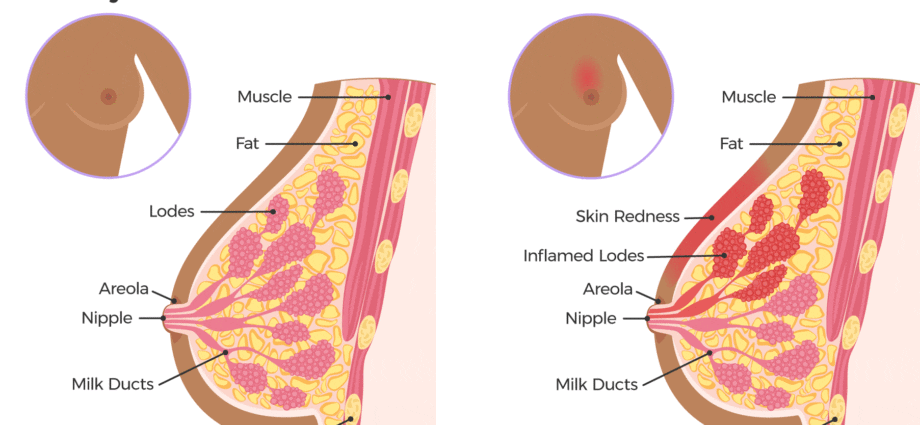Contents
Mastitis is common in nursing mothers. Johanna, lactation consultant and author of the blog Amour Maternel, explains: “Mastitis is linked to a stasis (stagnation) of milk in the mammary glands, or to the penetration of bacteria that cause a milk duct obstruction.
What are the symptoms of mastitis?
Painful, mastitis is sometimes difficult to identify because it can make you think of flu-like symptoms. In the middle of August 2020, Mathilda even thought about the coronavirus. “I did not immediately make the link between my painful breast and my slight fever”.
How do you know if you have mastitis?
“Unlike engorgement, mastitis is a inflammation of the mammary glands which results in localized painful tension, says Johanna. The area is hot and swollen. You can see a lump and redness in the breast. ” The inflammatory mastitis is usually accompanied by fever, aches and tiredness.
When Mathilda, 29 years old and mother of Faustine, 9 months old, had her first mastitis, her main fear was that this pregnancy problem would hinder her breastfeeding.
Causes of mastitis
We distinguish several factors which can lead to inflammation of the mammary gland:
- poor posture when breastfeeding
- a painful crevice that can be discouraging when it comes to breastfeeding
- an untreated blister of milk
- irregular breastfeeding
- too tight a bra
- significant fatigue
- in rare cases, the presence of a germ
How to prevent the onset of mastitis and relieve it?
The most effective solution for treating mastitis will be to drain the breast in order to eliminate milk stasis. “I encourage mothers to breastfeed their babies regularly during the day or to express their milk to relieve the painful breast,” advises the specialist.
Hot compresses and massages
Under the advice of her osteopath, Mathilda first performed manual drainage, in her sink, before breastfeed to his daughter. “The milk was coming into her mouth too quickly, causing regurgitation and sometimes even vomiting. After each feeding, the young mother applied hot compresses accompanied by massages to relieve pain, relax the breast tissue and facilitate breastfeeding. unblocking.
Vary positions while breastfeeding
A bad position of the baby during breastfeeding can also be the cause of the appearance of mastitis. “We must try to vary the postures in order to facilitate drainage of the different areas of the breast,” explains the lactation advisor. In case of mastitis already installed, we can try to breastfeed the baby in a position that allows his chin to press towards the blocked lactiferous duct to drain the breast as much as possible. “
If reposer
But for the specialist, mastitis must also be considered as the signal of an advanced state of fatigue. “This is not to be taken lightly. It is the sign of a épuisement which requires the mother to rest and take time for herself. “
Weaning, a good time for the onset of mastitis
Mathilda’s return to work resulted in irregular breastfeeding, one of the main contributors to mastitis. “I did not anticipate the start of the weaning enough, which was too brutal. I was sometimes embarrassed to express my milk in the office, my company does not have a locked room. My mammary gland was quickly inflamed and the appearance of a ampoule of milk didn’t make it easy for me, ”recalls the young mother.
“Weaning is a favorable period for the development of mastitis,” confirms lactation advisor. A baby who is starting to sleep through the night can also increase the time between feeds, which can lead to engorgement. »To prevent mastitis, regular drainage of the breasts is necessary.
Mastitis and breastfeeding: can I continue to breastfeed?
The answer is yes. “It is also the most effective way to overcome mastitis,” says Johanna. It may happen that the baby refuses to breastfeed because the composition of the milk will be a little more rich in sodium. In this case, a breast pump may be used to continue draining the breast and breastfeeding the child. “
How to cure infectious mastitis?
If after 48 hours the symptoms persist, make an appointment quickly with your doctor. A physical examination and a sample will confirm whether it is a simple inflammatory mastitis, or an infectious mastitis. a antibiotic treatment may be prescribed by the healthcare professional. In some cases, poorly treated infectious mastitis can lead to an abscess that may require surgery.
If your doctor confirms that taking the medication is compatible with breastfeeding, don’t worry! Even with infectious mastitis, your breast milk contains antibody that will protect your baby.










